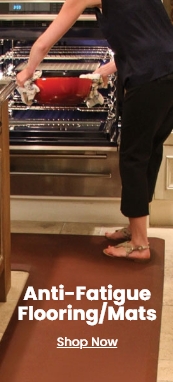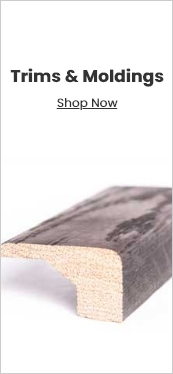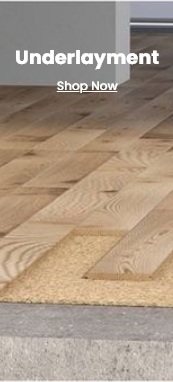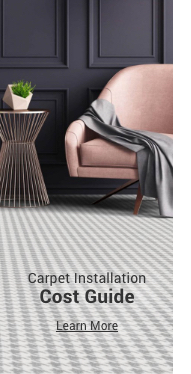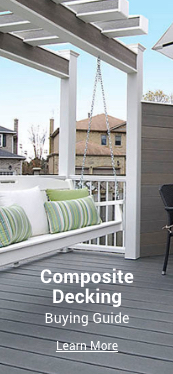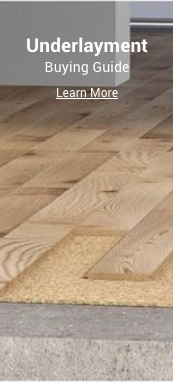How to Install Daltile’s RevoTile Flooring in 6 Easy Steps
| Fact Checked By: Ashley De Zeeuw
Published: February 20, 2020 | Updated: August 23, 2021
If you’ve been searching desperately for an easy way to install tile on your own, then today is your lucky day. Once you learn how to install RevoTile on your own, your DIY project will be so much simpler.
RevoTile offers an innovative tile installation system that’s as easy as place, click, and grout. No mortar, no mess, no more tiling nightmares. Cut installation time in half with this revolutionary porcelain tile that’s taking the flooring world by storm.
It’s not a gimmick, seriously! It’s really that simple, and I’m going to walk you through the whole process step by step, plus offer you a few handy tricks and tips that will help out along the way.
But before we get into all that, let me answer your biggest question.
Related Content >> Easy DIY Flooring Solutions
What is RevoTile?
RevoTile is an innovative tile flooring solution from Daltile. Durable, high-quality porcelain tile combines with Clic-fit technology, which ensures speedy installation with a durable, completely waterproof core.
Since you can interlock the tiles, you can float it over your subfloor or existing flooring. This click locking system also drastically reduces the time, money, and hassle that goes into installing tile.
Related Content >> Floor Tile Buying Guide
Materials to Install RevoTile Flooring
Even with the easiest floor tile installation method on the market, you can’t do it alone. To get the full limited lifetime warranty on your flooring, you need to use Datile’s specialized RAPIDPREP underlayment and grout. Using the full RevoTile system ensures the highest quality installation that you can get.
You should also bring along these tools and accessories to ensure your project is a success.
Daltile ClicFit install kit (wall spacers, tapping block, pullbar tool)
Safety Equipment (gloves, goggles, kneepads, dust mask), Level, Measuring Tape, Pencil, Straight Edge, Utility Knife, Rubber Mallet, Adhesive Tape, Grout Float, Margin Trowel, Microfiber Sponge, 5-Gallon Bucket, Manual Tile Cutter OR Wet Saw (for corner), Construction Adhesive, Caulk, Caulking Gun
Step One: Preparing For RevoTile Installation

One of the best things about RevoTile is that you can install it directly over existing flooring or your subfloor, so preparation is simpler and takes less time. You can install it over concrete, existing tile, hardwood, laminate, luxury vinyl, and rigid core vinyl. Do not install over carpet.
Before you start laying your beautiful new tile, you need to make sure your subfloor is the best it can be.
- Keep it clean. Sweep or vacuum the subfloor to remove any dust and dirt. The subfloor needs to be dry, clean, and level. Any big crack or dips should be addressed beforehand.
- Make sure the subfloor is level. The maximum height variation should be 3/16” over a 10’ range. If you’ve got more variation than that, you can level the subfloor by sanding down high spots and filling low areas with Portland cement, or some other recommended leveling product.
- Check for moisture. Concrete should have a moisture level below 80% relative humidity. Test the concrete by taping a square of plastic over the surface and leaving it overnight. If you peel back the plastic and find moisture the next day, the moisture level is too high.
- Measure doorways. Can your tile fit under the door? Place the tile and underlayment against the doorway to check the clearance. You might need to saw the door and frame to achieve a proper fit.
Related Content >> How to Tile a Floor
Step Two: RevoTile Underlayment Installation
RAPIDPREP underlayment is the key to your success. This allows you to lay out your tile flooring without the need for mortar.
- Unfold the first sheet. Spread out underlayment along the longest wall, making sure it’s completely flat. Fit it under the drywall or molding if possible.
- Position the next sheet. Place the next sheet beside the first, allowing the edges to touch. Note: Do not let the sheets overlap.
- Tape the seams. Secure the sheets together using tape along the seams. Be sure to follow the manufacturer’s instructions for this step.
- Cover the subfloor. Continue until the entire subfloor is covered.
Step Three: How to Install RevoTile Flooring
Finally, we can get to the fun part! Once you determine the direction you want to install the tile, and inspect them to ensure they’re the quality you expect, it’s time to install some tile.
- Measure the room. Take a measurement of the width of the room. Divide this number by the width of the tile. This will give you an idea of how many tile rows you need. If the last row is less than three inches wide, cut back on the width of the first row, so the first and last rows are even. This ensures a more balanced look in your space.
- Mix up your tile. Unbox your tiles and mix them up. This prevents any subtle color variations or pattern repeats from becoming noticeable.
- Place the first tile. Start in a corner, placing the tongue side of the first tile against the wall. Work left to right as you create the first row.
- Use wall spacers. Place 1/4” spacers between the wall and the tiles. Make sure to position the spacers again the tile, and not the base profile, as this could make the gap too large. Apply spacers along the entire perimeter to make sure the gap is even on all sides of the room.
- Lay the second tile. Secure tiles together along the short end. To do this, tilt up and press the tongue of the second tile into the groove of the first. Then lay the tile flat so they interlock.
Related Content >> Tile Flooring Trends
Complete the First Row
- Cut the last tile in the row. Measure the remaining space in the first row and cut the next tile to fit. We’ll get into more detail about cutting RevoTile a bit later.
- Even out the first row. Ensure that the first row of tiles is flush, so all the long edges are even and ready for the next row of tiles. Use a tapping block and rubber mallet to gently adjust any tiles for a better alignment.
- Start the second row. Use a cut piece of tile to create an offset from the first row. You can pick from a number of popular offsets, including 1/3 and 1/2 offsets. Angle the long end of the tile to press the tongue side into the groove of the first row. Press down until the tiles connect.
- Complete the rest of the room. For the remaining tiles, you have two ways to interlock them. You can connect the long side first, then use the tapping block and mallet to interlock the short ends. You may also attach the short side first and tap the tiles into place along the long side.
- Install the last row. Secure the final row into place with the help of the angle pullbar. This tool holds the outside tile edge and allows you to tap the tile securely into place.
- Alternative method (last row). If you can’t fit the pullbar into the edge space, you can also use construction adhesive to securely attach the tile to the subfloor. In this case, you would cut away the protruding tongue and groove section of the tile with a utility knife, while making sure you leave an even gap for grout.
Tip: If a tile profile gets chipped, but not the surface, you can often still use the tile. The profile can be chipped as long as 1” on the short side, or 2” on the long side, without the chips causing any connection issues.
Step Four: How to Cut RevoTile
- Take Measurements. Measure the space between the wall and the last tile, then mark your next tile to indicate the cut. Make sure to account for space for the grout joint and the expansion gap with the wall.
- Make the cut. You have two options for cutting tile: Use a manual tile cutter, or a wet saw, both of which you can rent at a home improvement store.
Tip: There are three main types of cuts you might need to make, and they all require different methods.
- For cuts straight across a tile, use a tile cutter. Manual tile cutters employ the score and snap method.
- A wet saw is required for corner cuts. For this method, mark the tile and carefully move the tile into the blade until you reach the mark, being sure not to go past it.
- For doorways and other bump-outs in the wall, you will need to use a combination of these methods, and then you’ll gently tap away the excess with a rubber mallet.
Related Content >> How to Install Backsplash Tile
Step Four: RevoTile in Doorways and Transitions
- Fit or adjust door frames. When floating RevoTile over existing flooring, make sure to measure the gap between the floor and the doorway. You may need to cut the bottoms of doors and doorframes for an ideal fit.
- Choose a flooring transition. There are a couple of options depending on the height of the tile compared to the floor you’re transitioning to.
- Both floors at the same level: Use a T-molding transition strip.
- One floor is taller: Install a reducer, with the lower side connecting with the lower flooring, and vice versa.
Step Six: How to Grout Revotile Flooring
Grouting is a crucial step in the tile installation process, made even easier with Daltile’s innovative RapidGrout. It’s a flexible grout that dries quickly and doesn’t require any additives like water. Here’s what you need to do to successfully apply grout.
- Make final checks. Observe for any gaps, loose tiles, or any joints that may not be properly clicked together. This is also the time to remove tile spacers along the perimeter.
- Mix the grout. Once you confirm the tiles are ready for the next step, prepare Daltile’s RapidGrout. This premixed grout doesn’t require any water, just a thorough mix with your trowel to account for any separation that may have taken place. Again, you should not add any water to this mixture.
- Pre-wet the tile surface. Dampen a microfiber grout sponge in a bucket of clean water, and pass it over the tile surface you’re about to grout.
- Use small amounts at a time. Because RapidGrout dries so quickly, it’s recommended that you only work in one small area at a time, so the grout doesn’t dry over the tile surface before you can clear it away. Three square feet is around the ideal area to work with.
- Apply the grout. Collect a workable amount, about the size of a baseball, and start working it into the tile joints. Using your grout float, press it into the joints at a 45 degree angle, making sure all gaps are filled completely.
- Clear away excess grout. Dampen your sponge and use it to wash the tile surface, being sure to thoroughly wipe the tiles at a 45 degree angle to the joints. Be careful not to pull out any grout that’s actually in the joints. Change the water regularly to ensure it’s always clean.
Continue Grouting
Repeat this process of gradually grouting and washing until the entire floor is complete.
- Remove grout haze. It’s possible that some grout was left behind in the cleaning process, and after a few hours, you will notice a thin, hazy layer of grout left over. To clear this haze, you can use a window cleaner or specialized grout haze remover, depending on the manufacturer’s instructions.
- (Optional) Caulk the perimeter. In high-moisture areas, like bathrooms or laundry rooms, it can be a good idea to apply a sealant of caulk around the edges of the room. This protects you from water damage at the base of your walls.
- Let the grout cure. Before you start enjoying your new tile floor, you need to let the grout lines fully cure. This will create the most secure bond between the grout and the tile. Check the manufacturer’s instructions to discover the recommended waiting time.
Related Content >> How to Clean and Seal Grout
Replacing RevoTile Flooring
Right out of the gate, you’re going to discover that RevoTile is tough. It’s designed to be durable and scratch-resistant, so you don’t need to worry too much about a damaged tile. Still, if a tile does get cracked or chipped, you can replace it without a lot of difficulties. Here’s how:
- Remove grout around the damaged tile. Use a rotary cutting tool to very carefully cut away any surrounding grout. Be sure not to cut into adjacent tiles or the underlayment during this process.
- Pull up the damaged tile. You can use a pry bar to carefully lift away the tile.
- Trim the new tile to fit. The tile profile, which is designed to interlock with the other tiles, needs to be cut away so the new tile can fit into place. Before adhering the new tile, lay it into place for a “dry run.”
- Secure the tile with construction adhesive. Once you’re sure everything fits and is even, apply construction adhesive to the bottom of the tile. Press it firmly into place.
- Apply grout. Once the construction adhesive is properly dry and the new tile is set into place, you can finish the project by grouting the tile joints. Follow the same steps as if you were grouting normal tile.
How to Clean and Maintain RevoTile
Now that you’ve got a beautiful, brand new floor, it only makes sense that you want to keep it looking its best. RevoTile is already waterproof, stain-proof, dent-proof, and scratch-resistant, so you can expect it to handle everyday challenges without a problem. Follow these steps to make sure it’s always performing at its best.
- Clean up spills quickly. Use a mop or cloth to clear away spills before they get the opportunity to stain. Typical household cleaners or a mild soap and water solution can help with this.
- Ensure regular upkeep. Sweep, vacuum, or mop your floor on a regular basis to get rid of any dust or dirt.
If you keep these tips in mind, your floor is going to look great for years and years to come! And who doesn’t want that?
Conclusion
Now you know how easy it is to install Daltile’s RevoTile flooring. It’s pretty Revolutionary, don’t you think? But seriously, it’s going to save you so much time and money, and prevent so many headaches. It’s designed with the DIYer in mind, but even a contractor is going to love how simple it is to install RevoTile.
If you have any more questions or want to learn more, check out our RevoTile products to get even more detailed information!











